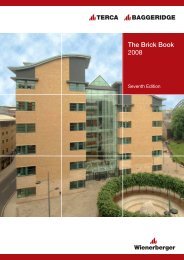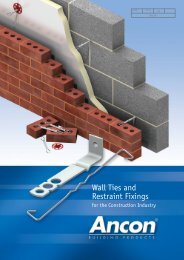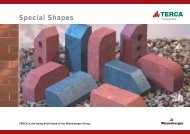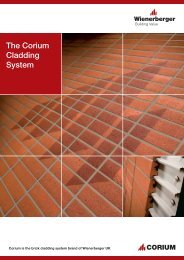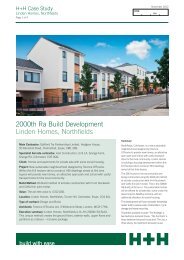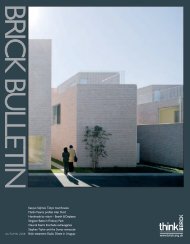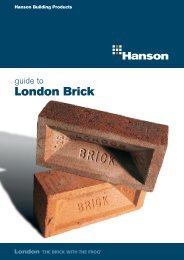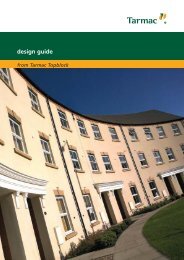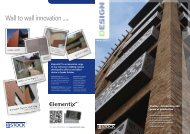Thermal Performance: Part L1A - Masonryfirst.com
Thermal Performance: Part L1A - Masonryfirst.com
Thermal Performance: Part L1A - Masonryfirst.com
You also want an ePaper? Increase the reach of your titles
YUMPU automatically turns print PDFs into web optimized ePapers that Google loves.
<strong>Thermal</strong> <strong>Performance</strong>: <strong>Part</strong> <strong>L1A</strong>Acoustic performanceThe October 2010 update of the Robust Details Handbook containsguidance on separating walls which can be fully filled withoutaffecting acoustic performance. The insulation material in the cavityshould be mineral wool insulation with a maximum density of 40kg/m³. This applies to all lightweight aggregate (1350-1600kg/m 3 ) anddense aggregate (1850-2300kg/m 3 ) walls previously specified withclear cavities. Additionally, three clear-cavity aircrete walls have theoption to be insulated with Isover’s RD <strong>Part</strong>y Wall Roll. This means thatthere are now Robust Details for 15 masonry separating walls whichhave the ability to achieve a zero U-value, subject to BCB approvalthat the insulation has provided cavity fill sufficient to meet the <strong>Part</strong> Lrequirements [13].<strong>Thermal</strong> bridging(repeating)Repeating thermal bridges are those occurring regularly in allconstruction elements. They include ceiling joists, studwork in walls,mortar joints in lightweight blockwork and wall ties. The effect ofconventional wall ties on U-values is negligible in cavities of 125mmor less.However, the more substantial ties traditionally used in cavities over125mm can increase heat loss. To a limited extent, this undermines thebenefit of the thicker insulation made possible by a larger cavity. Tocounter this, low thermal conductivity ties are available, such as basaltfibre wall ties. These are used in the same way as conventional ties buthave a thermal conductivity of only 0.7 W/mK (around 20 times less thanstainless steel). This is less than the 1.0 W/mK wall tie threshold appliedin U-value calculations, below which the level of thermal bridging is solow, it is ignored.Another option is to use stainless steel ties with a minimal crosssectional area to ensure low thermal conductivity. Depending on thecavity width, the bridging effect of these ties may be less than 3% of awall’s U-value, in which case it is not included in the U-value calculation.Examples include Type 3 wire ties with a cross sectional area of 8.6mm 2and a new Type 4 tie [14] with a cross section area of just 6.2 mm 2 .Contact your preferred walltie manufacturer for the latest information.Low conductivity basalt fibre wall ties. Courtesy of Ancon Building Products.Specifying wall tiesFor traditional masonry construction, wall ties shouldbe selected from the Types 1 to 4 in PD 6697:2010.Re<strong>com</strong>mendations for the design of masonry structuresto BS EN 1996-1-1 and BS EN 1996-2 (EC6). This PublishedDocument <strong>com</strong>prises non-contradictory <strong>com</strong>plementaryinformation from the now withdrawn British Standard BS5628-1, BS 5628-2 and BS 5628-3.<strong>Thermal</strong> bridging(non-repeating)A course of blocks made from foam glass or a concrete-polystyrene <strong>com</strong>positeprovide new ways of ensuring the very lowest level of cold bridging at groundfloor junctions. Courtesy of Marmox (UK) ltd and Pittsburgh Corning (UK) LtdThe previous version of SAP (2005 edition) dealt with heat lossthrough thermal bridging by allowing a global y-value (W/m 2 K) to bespecified for a dwelling, which varied according to the performanceof construction details used. For junctions conforming to the 2006Accredited Construction Details (ACDs) the global y-value was taken to be0.08 W/m 2 K.However, from October 2010 the global y-value was substituted bya dwelling specific value of heat loss from thermal bridging (H TB )calculated individually for each dwelling. This in-turn is based on thelength (L) of each thermal bridge multiplied by its linear thermaltransmittance value (c), in other words: H TB = ∑ (L x c)This is more onerous for the designer, but in no way prevents the useof ACDs (and their associated c values); use of which is encouraged asa means of ensuring a good standard of performance and buildability.Appendix K of SAP 2009 contains published values of c for a range of2006 accredited junction details. While these can be used for all thedetailing or in <strong>com</strong>bination with non-accredited details from othersources, a performance penalty must be added to all non-accrediteddetails i.e. those that have not been subject to an independentassessment. The penalty is either a 25% increase in the calculated valueor an increase of 0.02 W/mK, whichever is the greater. However, at thetime of writing no scheme for new accredited construction details hadbeen approved by the Secretary of State and until such time that itis, calculated values of linear transmittance may be used without anyperformance penalty applied (providing they are calculated by a suitablyexperienced and qualified person e.g. those that have <strong>com</strong>pleted andpassed BRE training or similar).10



